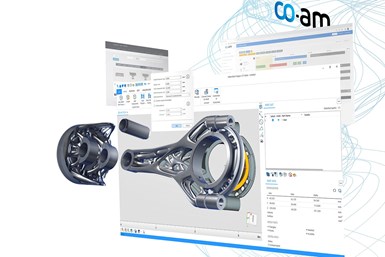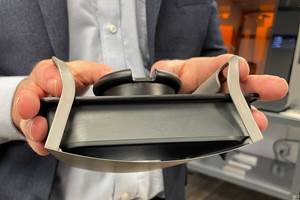Enhanced Magics Software Enables Traceability, Connectivity, Automation
Materialise’s updated Magics workflow automation software helps improve product quality by creating an advanced digital thread connecting the entire manufacturing process.
Share
Materialise, a global provider of 3D printing software and service solutions, has introduced new features to Magics, its data and build preparation software. From product design to part and build preparation to printing, the digital thread connects the entire manufacturing process. The company says that the connectivity and traceability are crucial to facilitate this. That’s why the most recent update of Magics prioritizes connections with other software solutions.
Magics’ integration with CO-AM adds traceability to the 3D printing process with a revision tree that logs every action applied to a part or build, including which user performed it. This connection between data and build preparation software and manufacturing execution systems is critical to track part status from end to end, but is often missing due to silos between software.
“Traceability is critical for any 3D printing production,” says Egwin Bovyn, product line manager at Materialise. “It’s not only a requirement for highly regulated industries like aerospace but also plays an important role in quality improvement. Tracking the parameters of past builds gives users insights into what goes right and what goes wrong. It gives them a detailed log to refer to while improving their processes.”
This update also introduces integration between Magics and Materialise Machine Manager, which connects users to their Build Processors to send project information and parameters necessary to make successful builds.
“By connecting Magics to our Machine Manager, we’re offering a new cloud-based solution to manage your AM machine park and connected Build Processors,” explains Brecht Pellens, product manager at Materialise. “Cloud-based working is inherently more collaboration friendly — users no longer need to rely on one workstation for all their build preparation work — so sharing files and processing parameters with colleagues is also easier than ever. Plus, all processing parameters and build files are now stored in the cloud, continuing the traceability factor in this stage of your workflow.”
Another spotlight feature from the Magics update is Workflow Automation’s first off-the-shelf script. Workflow Automation is a Magics tool that offers ready-to-use and custom scripts — developed by Materialise or the user — to automate repetitive workflows during data and build preparation. The first off-the-shelf script — smart labeling — was created for use by Protolabs and automatically labels parts in minutes. Additional Workflow Automation scripts will be made available later this year.
"Labeling 20 parts takes just one person maybe five minutes with our new automated workflow. Before, it was an hour and a half, two hours for two people. It wasn't fun work,” says Christoph Erhardt, manager of customer projects and additive design at Protolabs. “And now the team experiences less stress and uses their time for more challenging, interesting work that truly motivates them."
- Read how Materialise expanded its CO-AM Platform with seven technology partners to connect and automate all steps of the AM process, including automating design, labeling, machine monitoring and postprocessing.
- Learn about the Materialise acquisition of Identify3D software encryption company in order to add an additional security layer to its CO-AM platform, making it an even more robust and secure software platform for distributed manufacturing.
- Here’s an article offering more details on Materialise’s CO-AM Software for serial additive manufacturing (AM) production, which is designed to give manufacturers cloud-based access to a full range of software tools that enable them to plan, manage and optimize every stage of their AM operations.
Related Content
DMG MORI: Build Plate “Pucks” Cut Postprocessing Time by 80%
For spinal implants and other small 3D printed parts made through laser powder bed fusion, separate clampable units resting within the build plate provide for easy transfer to a CNC lathe.
Read MoreFormlabs Part Removal Mechanism Enables Lights-Out Production
A build platform overcoming the need for manual part removal enables automated part handling, and therefore continuous production from one build cycle to the next.
Read MoreCopper, New Metal Printing Processes, Upgrades Based on Software and More from Formnext 2023: AM Radio #46
Formnext 2023 showed that additive manufacturing may be maturing, but it is certainly not stagnant. In this episode, we dive into observations around technology enhancements, new processes and materials, robots, sustainability and more trends from the show.
Read More3D Printed End of Arm Tooling Aids Automation
Frustrations with traditional end of arm tooling led Richard Savage to start 3D printing custom versions for injection molding applications, eventually founding a company to fill this niche.
Read MoreRead Next
At General Atomics, Do Unmanned Aerial Systems Reveal the Future of Aircraft Manufacturing?
The maker of the Predator and SkyGuardian remote aircraft can implement additive manufacturing more rapidly and widely than the makers of other types of planes. The role of 3D printing in current and future UAS components hints at how far AM can go to save cost and time in aircraft production and design.
Read MoreHybrid Additive Manufacturing Machine Tools Continue to Make Gains (Includes Video)
The hybrid machine tool is an idea that continues to advance. Two important developments of recent years expand the possibilities for this platform.
Read More3D Printing Brings Sustainability, Accessibility to Glass Manufacturing
Australian startup Maple Glass Printing has developed a process for extruding glass into artwork, lab implements and architectural elements. Along the way, the company has also found more efficient ways of recycling this material.
Read More











.png;maxWidth=300;quality=90)












